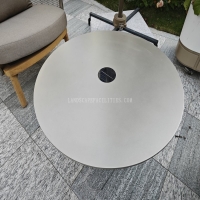Welcome to the website for landscape facilities products and knowledge.
How does the table’s design facilitate easy integration with outdoor art installations?
In the evolving landscape of contemporary outdoor spaces, the strategic design of tables has become pivotal for creating harmonious relationships with art installations. Unlike conventional furniture, purpose-built outdoor tables incorporate specific features that transform them from mere functional objects into integral components of artistic environments.
The foundation of this integration begins with material selection. Designers increasingly utilize weather-resistant substances like powder-coated aluminum, marine-grade polymers, and naturally weathering steels that mirror the durability requirements of outdoor sculptures. These materials don't merely withstand environmental challenges—they evolve aesthetically alongside adjacent artworks, developing patinas that enhance rather than detract from the artistic experience.
Modularity represents another critical design consideration. Contemporary outdoor tables frequently employ adaptable systems comprising interlocking units that can be reconfigured to complement various installation scales and layouts. This flexibility allows landscape architects to create dynamic relationships between functional surfaces and artistic elements, whether arranging tables in radial patterns around central sculptures or designing linear formations that guide movement through installation spaces.
The visual dialogue between table and artwork extends to formal design elements. Tables with transparent surfaces or open framework constructions maintain visual permeability, ensuring sightlines to installations remain unobstructed. Conversely, solid-surface tables may incorporate finishes, textures, or colors that either create deliberate contrast with nearby artworks or establish subtle tonal continuities. This careful balancing of visual weight and materiality prevents either element from dominating the space.
Practical integration solutions include embedded mounting systems that allow temporary or permanent attachment of artistic elements to table surfaces. These discreet fastening mechanisms—such as flush-mounted receivers or magnetic docking stations—enable tables to physically support smaller installations while maintaining clean aesthetics when not in use. Additionally, integrated lighting within table structures can dramatically enhance nighttime visibility of adjacent artworks, extending their functional appreciation beyond daylight hours.
Perhaps the most sophisticated integration occurs through collaborative design processes, where tables and installations are conceived as complementary elements from inception. This approach yields tables with custom-designed bases that echo formal motifs in nearby sculptures, or surfaces that incorporate artistic patterns extending from adjacent installations. The resulting environments demonstrate how thoughtful table design transcends utility to become an active participant in the artistic narrative of outdoor spaces.
The ultimate success of these integrated designs lies in their ability to create environments where functionality and artistry coexist without compromise. Through strategic material selection, adaptable configurations, and deliberate aesthetic choices, outdoor tables can elevate rather than merely accompany art installations, fostering enriched experiences that resonate with viewers on multiple levels.
Related search:

Recommendation
Outdoor stainless steel table with solar-powered ambient lighting feature - excellent design.